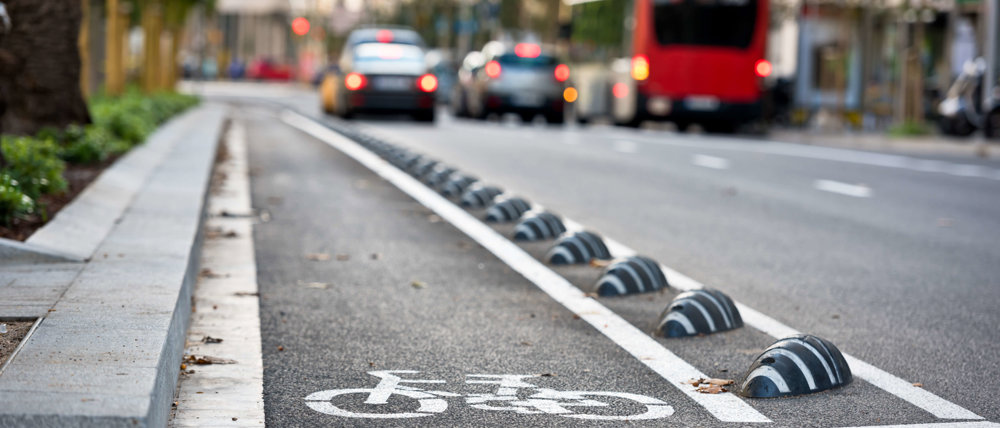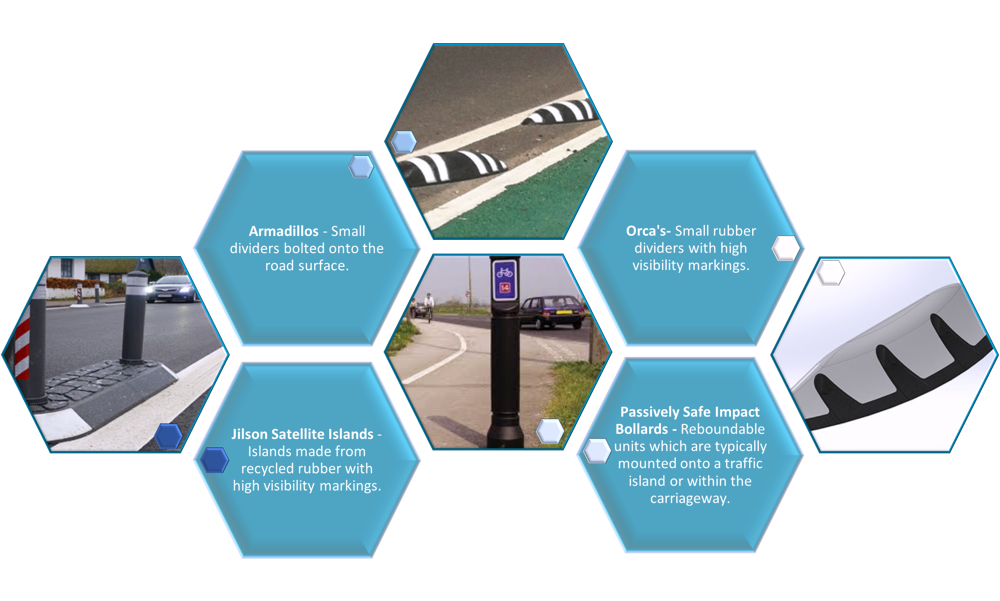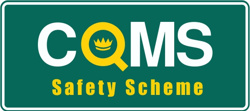Orcas and Armadillos are both common light segregation methods used as cycle lane delineators in the UK. The official use of light protection schemes in the UK was launched in 2013, with Orcas and other delineators now a common sight as the UK’s cycle network expands. While they are designed to protect cyclists by providing a physical buffer preventing vehicles from entering cycle lanes, many believe that these devices cause more harm than good. Reports have highlighted concerns over the devices destabilising motorcyclists, creating trip hazards for pedestrians, and even cyclists are at risk when low-level devices are damaged by vehicles leaving parts strewn on the road.
Why focus on them now?
Cycling has been a big focus in recent government policy, with the Department for Transport (DfT) publishing its ‘Gear Change, A bold vision for cycling and walking’ document in July 2020 and a guide to reallocating road space in response to Covid-19 was published in January 2021. Additionally, as the country has moved through the successive lockdowns resulting from the Covid-19 pandemic one thing has remained clear, the huge increase in active travel. In fact, a DfT national travel attitudes study revealed that of those who were reporting to walk and cycle more, 94% thought it likely they would continue to do this more once travel restrictions were removed. However, as cycle networks expand as a response to this demand and through additional government funding, so will the light segregation methods that are commonly installed alongside. It is therefore important to understand what these methods are and whether they are safe or are causing more harm than good.
What Are the Types of Light Segregation?
Chapter 4 of the London Cycling Design Standards (LCDS) defines light segregation as the use of physical objects intermittently placed alongside a cycle lane marking to give additional protection from motorised traffic. There are lots of types of light segregation methods, the most common are:
- Armadillos
- Orcas
- Jilson Satellite Islands
- Passively Safe Impact Bollards
(Image sources: Orca – rediweldtraffic.co.uk , Armadillo – Gov.uk, Jilson Satellite Island – rediweldtraffic.co.uk, Passively Safe Impact Bollards – Glasdon.com)
Other types include Planters, Concrete Blocks, Wands and Cycle Lane Defenders.
What are the pros and cons of using Light Segregation devices?
Evidence from trials across the UK have found a wide range of benefits from the use of light segregation devices, as well as some flaws:
Pros
- The devices are better than nothing; having no segregation at all leaves cyclists vulnerable to motor vehicles.
- If correctly placed, light segregation devices stop drivers parking in cycle lanes.
- Value for money compared to more expensive methods such as kerb-separated cycle tracks.
- Easy to install and adaptable, for example Armadillos are bolted into the road surface therefore they can easily be repositioned if necessary.
- Increased use of routes as cyclists feel, or perceive to be, more protected.
- For example, The Royal College Street scheme in Camden was monitored for 15 months and during this time the number of cyclists using the route increased by 70% and collisions reduced by 83%.
Cons
- If too widely spaced or too small light segregation devices do not discourage drivers drifting into cycle lanes or parking in them.
- There have been many reports of pedestrians tripping over Orcas and hurting themselves.
- For example, a trial in Camden (Aldergate Scheme) saw 55 pedestrian falls within a 24-hour period as a result of pedestrians tripping over MiniOrcas.
- There is a risk for Powered Two Wheelers that they are forced towards segregation by a ‘side swipe’ manoeuvre and then are destabilised.
- They are not particularly durable.
- Flexible posts can look temporary and diminish the attractiveness of the street.
- Cyclists collide with the Armadillos or posts due to wobble or misjudging the width required whilst overtaking slower cyclists.
- Damaged Orcas and Armadillos often leave bolts or screws in situ, creating a hazard for cyclists and other road users.
- Orcas and other light segregation methods often become less conspicuous over time due to the build-up of detritus.
- For example, an Orcas scheme looked at by Mayer Brown Ltd. in Walthamstow found that Orcas had become rather inconspicuous after just 6 months of the scheme running.
- If too tightly spaced, cyclists are restricted from moving out of the cycle lane to turn right.
While no research to date has found any significant issues regarding light segregation methods inducing a risk to other road users, concerns have been raised by motorcyclists about their safety and from HGV drivers worried they will strike low level separators.
The British Motorcyclists Federation (BMF) and Motorcycle Action Group (MAG) feel very strongly that forms of light segregation are hazardous to riders and pedestrians and issued a joint statement in 2016 raising their concerns. The statement raised the issue of destabilising those on Powered Two Wheelers and throwing them into the path of other road users, and how easily the devices are damaged by heavy vehicles leaving bolts on the road surface creating a hazard for many.
Research - Glasgow City Council Soft Segregation Study
In February 2020, Glasgow City Council (GCC) published their ‘Cycle Lane Soft Segregation Trial Report’ detailing results from a number of trials across the city. Six locations were chosen with a variety of soft segregation methods installed at each; these were then monitored to see how each product stood up to climate and how durable they were with the time between installation and review ranging between two and seven years. A summary of the results of the report is presented in Table 1 below:
Table 1: Results of Glasgow City Council Soft Segregation Report
Table 1 shows that the success of each type of segregation varied between locations. Passively Safe Impact Bollards were overwhelmingly found in good condition at the majority of sites where they were installed. Comparably, 94% of Orcas were found in good condition in one location while 74% were found damaged in another. The two locations where cycle lane defenders were installed had none in good condition when the sites were surveyed. These results clearly highlight that some segregation methods are more appropriate for certain locations than others. It also highlights that all methods featured some kind of damage during the trial at all locations.
Based on these results, GCC set out a recommendation that a maintenance plan should be in place to address blocking of weep holes in Orcas, Defenders and Armadillos, regular cleansing of Orcas and Armadillos, regular replacement of reflective strips and on cycle lane defenders and regular inspections to check loose or missing bolts and broken or missing units.
Mayer Brown’s Experience
The road safety auditing team at Mayer Brown Ltd. have extensive experience of light segregation schemes, including on some heavily trafficked London Streets. From this experience, concerns have been raised over the use of Orcas, primarily due to the damaged Orcas creating a hazard themselves, their lack of conspicuity due to dirt and frequent over-running by vehicles. It is evident that Orcas need high levels of maintenance from highway authorities for them to be used safely and effectively. Similar concerns are raised about low-level planters which are difficult and dangerous to maintain, are at the right height to catch a cycle pedal, and if struck by a motor vehicle would be potentially hazardous to cyclists and other road users alike.
Concluding Thoughts
The types of segregation that are more permanent (Posts, Concrete Blocks and Planters) are more expensive to install and are less adaptable but are more durable and less likely to become damaged. They are easily seen so are less likely to cause harm to motor vehicles or Powered Two Wheelers but are more difficult for pedestrians to navigate.
In comparison, the low-level types of segregation that can be overrun by vehicles (Orcas, Armadillos and Satellite Islands) are much cheaper and are adaptable so can be easily changed if and when necessary. However, these types are more likely to become damaged and require higher levels of maintenance. There are also arguments to suggest they are a trip hazard for pedestrians and can destabilise motorcyclists.
Therefore, it is essential that where light segregation devices are being installed, the most appropriate type is chosen for the location. Considerations should be made for the level of motor traffic, the level of both cyclists and pedestrians using the area and the appropriate spacing of devices to ensure a balance between aesthetics and prohibiting parking in cycle lanes. Post-implementation monitoring should always be undertaken, as well as a maintenance plan in place. Above all, light segregation devices should be clearly visible to all road users and should work symbiotically with obvious road markings. While there is a propensity to fast-track cycle lane and light segregation implantation as a result of the increased uptake of cycling in a post-Covid world, consultations with user groups should still be a priority to ensure that user needs are met properly.
For more information on this topic or to talk to our road safety auditing team, please contact us.
Bibliography of Useful Links
Light Protection of Cycle Lanes - Best Practices (itf-oecd.org)
Safety concerns raised over ‘cycle lane delineators’ (roadsafetygb.org.uk)
Cycling - Light Segregation (rospa.com)
Cycle Lane Soft Segregation Trial Report (glasgow.gov.uk) - linked in the text
Gear change: a bold vision for cycling and walking (publishing.service.gov.uk) - linked in the text
National Travel Attitudes Study (NTAS) - Wave 4 (publishing.service.gov.uk) - linked in the text
LCDS Chapter 4 Cycle Lanes and Tracks (tfl.gov.uk) - linked in the text









